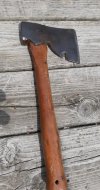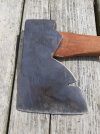- Joined
- Mar 2, 2013
- Messages
- 1,772
It's been said before, and I believe it too, but once the saw was introduced understanding of wood greatly diminishes. After all, sawing requires not so much reckoning with the structure of wood as a material, while working with an axe does. The simple example of making a notch at the corner of a plank can illustrate.


The grain of the wood is sloping inward in relation to the right angle of the notch so that a split coming from the end grain will take it beyond the corner and requires working in the opposite direction, or from the cut out towards the end.

And from there paring back to the lay-out.

for a good fit around the cabinet's rail.

At another corner with the wood working more in our favor a simple split and chop will work just fine, acknowledging all the time the convenience of the saw when it comes to working perpendicular to the grain. Also we can see the advantages of the well evolved subtitles featured in a suitable axe, in this case the so-called Dumstorfer carpentry axe.


The grain of the wood is sloping inward in relation to the right angle of the notch so that a split coming from the end grain will take it beyond the corner and requires working in the opposite direction, or from the cut out towards the end.

And from there paring back to the lay-out.

for a good fit around the cabinet's rail.

At another corner with the wood working more in our favor a simple split and chop will work just fine, acknowledging all the time the convenience of the saw when it comes to working perpendicular to the grain. Also we can see the advantages of the well evolved subtitles featured in a suitable axe, in this case the so-called Dumstorfer carpentry axe.
Last edited:















